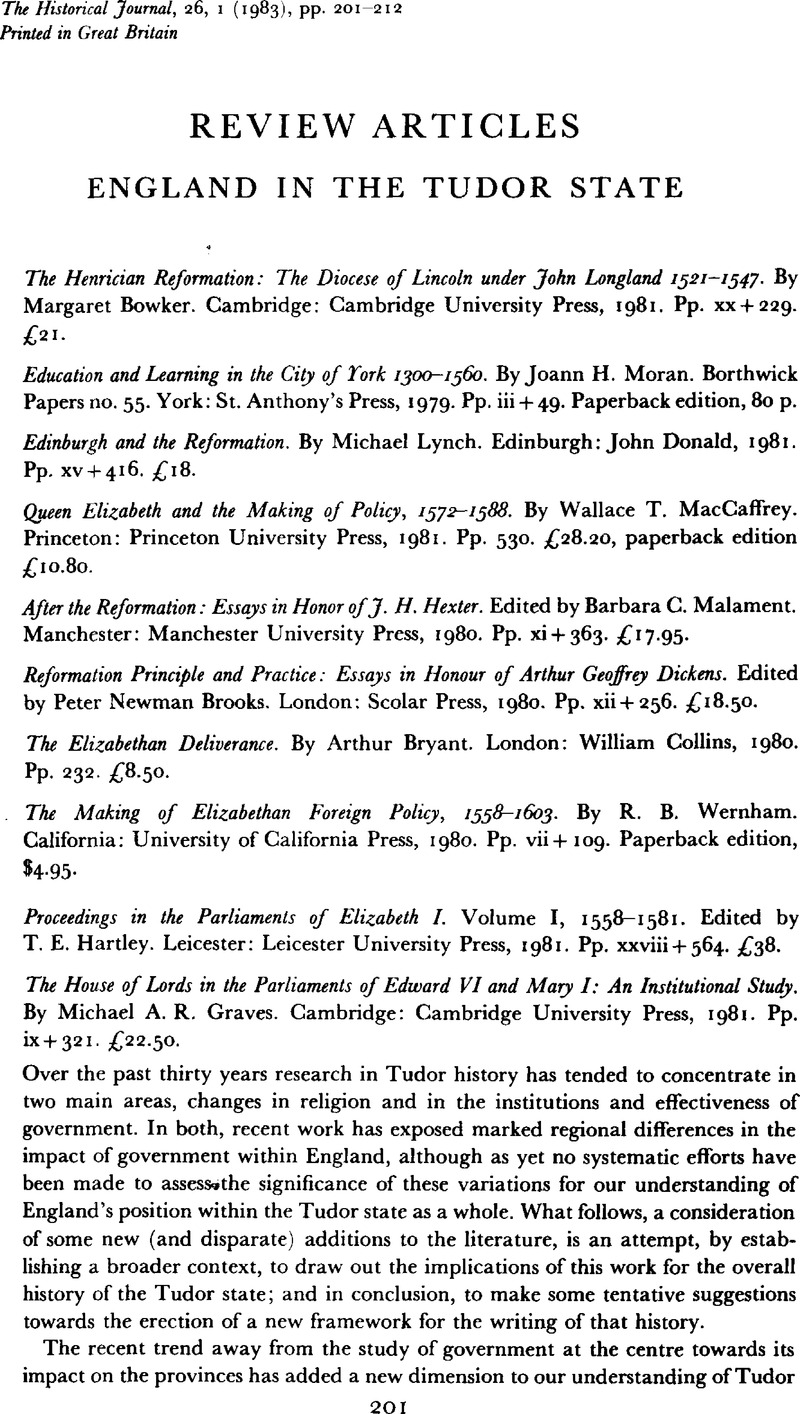Article contents
England in the Tudor State
Published online by Cambridge University Press: 11 February 2009
Abstract

- Type
- Review Articles
- Information
- Copyright
- Copyright © Cambridge University Press 1983
References
1 For a convenient summary, Penry Williams, The Tudor regime (Oxford, 1979), pp. 428–52Google Scholar. Bush, M. L., ‘The problem of the far north: a study of the crisis of 1537 and its consequences’ in Northern History, vi (1971), 40–63.CrossRefGoogle Scholar
2 See especially Haigh, Christopher, ‘The recent historiography of the English Reformation’ in Historical Journal, xxv (1982), 995–1007 for this and much of the following two paragraphs.CrossRefGoogle Scholar
3 Orme, Nicholas, Education in the west of England 1066–1548 (Exeter, 1976)Google Scholar. Cf. Simon, Joan, Education and society in Tudor England (Cambridge, 1966).Google Scholar
4 Philip Broadhead, ‘Politics and expediency in the Augsburg Reformation’ in Brooks (ed.), Reformation principle and practice, pp. 55–70.
5 R. B. Walker, ‘A history of the Reformation in the archdeaconries of Lincoln and Stow, 1534–94’ (Ph.D. thesis, Liverpool University, 1959); ‘Reformation and reaction in the county of Lincoln, 1547–58’ in Lincolnshire Archaeological and Architectural Society Reports and Papers for 1961, n.s., ix, pt i (1962), pp. 49–62; ‘The growth of puritanism in the county of Lincoln in the reign of Queen Elizabeth I'in Journal ofReligious History, 1 (1961), 148–59; G. A. J. Hodgett (ed.), The state of the ex-religious and former chantry priests in the diocese of Lincoln, 1547–1584 (Lincoln Record Society, vol. 53,1959); Tudor Lincolnshire (Lincoln, 1975); Bowker, Margaret, Thesecular clergy in the diocese of Lincoln 1495–1520 (Cambridge, 1968).Google Scholar
6 Secular clergy in the diocese of Lincoln.
7 ‘Salvation by coercion: the controversy surrounding the “Inquisition” in the Low Countries on the eve of the revolt’ in Brooks (ed.), Reformation principle and practice, pp. 137—56.
8 ‘Priests into ministers: the establishment of Protestant practice in the city of York, 1530–1630’, ibid. pp. 205–25.
9 Wilson, Elizabeth and the Netherlands, p. 6.
10 See especially, Ciarán Brady, ‘The government of Ireland, c. 1540–83’ (Ph.D. thesis, Dublin University, 1980).
11 ‘Politics and the Pilgrimage of Grace’ in Malament (ed.), After the Reformation, pp. 25–56.
12 Graves, House ofLords, p. 50.
13 MacCaffrey, Elizabeth and the making of policy, pp. 14–15.
14 ‘Towards a more perfect union: England, Scotland, and the Constitution’ in Malament (ed.), After the Reformation, pp. 57–74.
- 2
- Cited by


